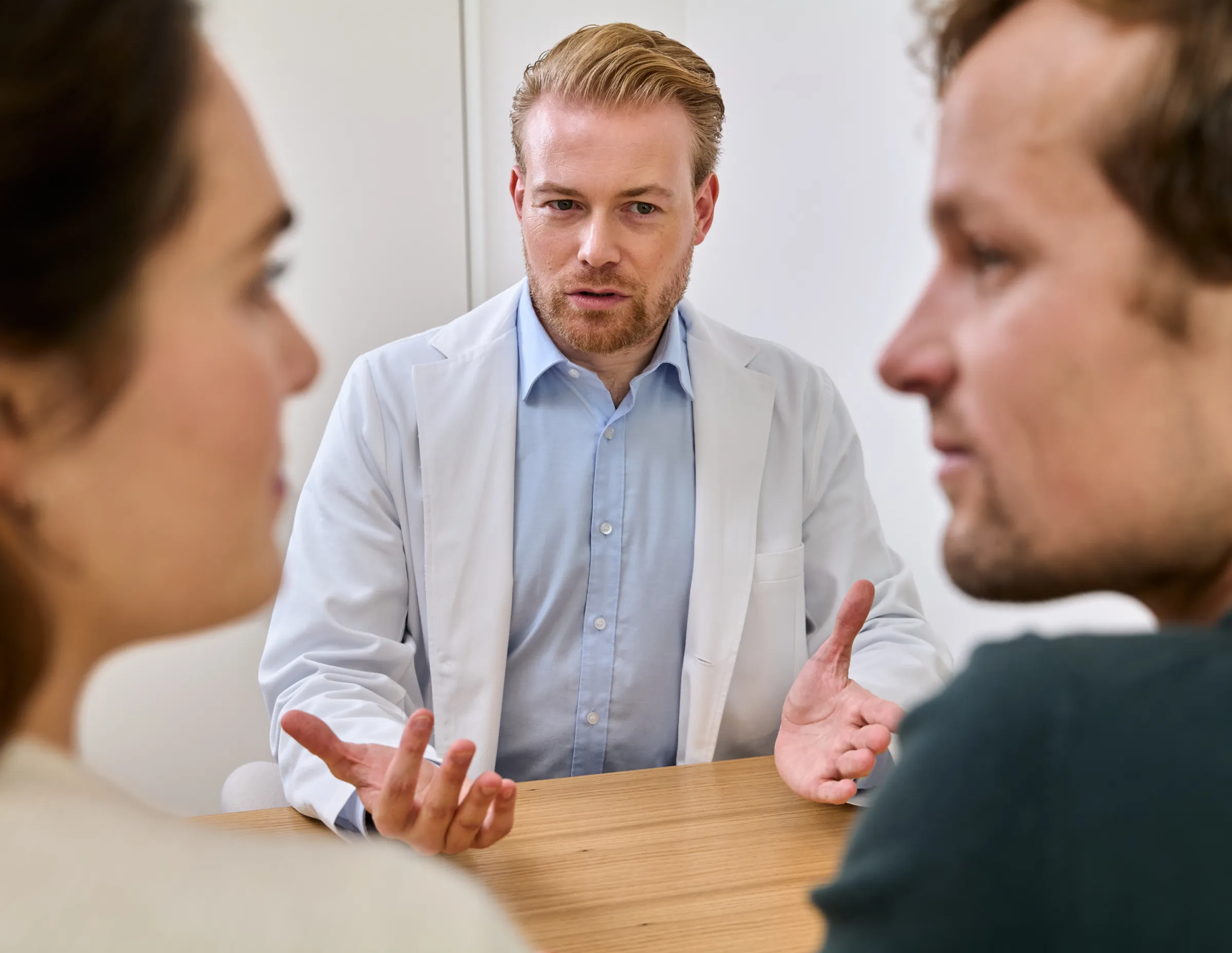What does an ovarian cyst mean for your health and fertility? We discuss the different types of cysts, their impact, and whether treatment is needed.
Learning that you have an ovarian cyst can be concerning. But what does it mean for your health and fertility? Below, we explain the different types of ovarian cysts, how they could impact your chances of becoming pregnant, and how they're treated.
What are ovarian cysts?
Ovarian cysts are sacs containing fluid or tissue which can be found on or inside of the ovaries. They are common, with one study finding that 35% of premenopausal and 17% of postmenopausal women examined by transvaginal ultrasound had at least one. Most ovarian cysts are small and harmless, resulting in no symptoms or pain. This is why they usually go undetected, disappearing over time without the need for medical help.
However, cysts may also cause pain and discomfort, especially if they grow to a certain size, and they can indicate certain conditions that make it more difficult to become pregnant.
Types of ovarian cysts and how they develop
Ovarian cysts can form on the surface or inside of an ovary. They can be either solid or filled with fluid, and typically range in size between 1–4 cm in diameter (although they can sometimes grow to 5 cm or more). Below, we outline the main types and how they come about.
| Cyst type | Cause | Contents | Impact on Fertility |
|---|---|---|---|
| Functional | Normal follicle development leading to ovulation (failure of ovarian follicle to release an egg or blockage after release, leading to fluid buildup in the corpus luteum) | Fluid | Generally none |
| Cystadenoma | Growth on the surface of the ovary | Fluid or mucous | Generally none |
| Dermoid | Bodily tissue collecting in an unusual place (here, the ovary), usually before birth | Tissue (skin, hair or even teeth) | Generally none |
| Endometrioma | Endometriosis, in which tissue similar to the endometrium (uterine lining) grows outside of the uterus (here, in the ovary) | Menstrual fluid (the appearance of old blood gives them the name “chocolate cysts”) | Possible impact |
| PCOS-related | Polycystic ovarian syndrome (PCOS), which is associated with clusters of small ovarian cysts. These occur when a woman’s ovarian follicles do not successfully release their eggs. | Fluid | Possible impact |
What are the risk factors for ovarian cysts?
In addition to their association with endometriosis and PCOS, ovarian cysts are more likely to develop when a woman has a pelvic infection. Pregnant women are also more likely to have corpus luteum cysts. A history of ovarian cysts is also a risk factor—women who have had one before are more likely to get one again.
What are the symptoms of ovarian cysts?
Most ovarian cysts are harmless, cause no symptoms, and resolve on their own in time. However, large cysts are more likely to cause discomfort, especially if they grow rapidly, or cause the ovary to become displaced or twisted (known as ovarian torsion). It also sometimes happens that a cyst ruptures (bursts), at which point its contents are released into the abdominal cavity. While the body can often reabsorb this material, it is also possible for it to lead to infection.
Symptoms of cysts can include:
- Pelvic pain or abdominal pain which radiates to the lower back
- Frequent bloating or indigestion
- Changes in your bowel habits including difficult and painful movements
- Pain during sex
- Nausea and vomiting
How do ovarian cysts affect fertility?
Functional cysts, cystadenomas, and dermoid cysts generally do not affect one’s chances of becoming pregnant, even though they may require surgical treatment if they continue to grow. Cysts that are associated with endometriosis or PCOS may be associated with infertility, but it is unclear whether this is due to the cysts themselves, or more due to the underlying condition. Studies show that 30–50% of women with endometriosis experience infertility, while fertility problems are also common with PCOS. It is also worth mentioning that procedures to remove cysts can themselves impact fertility.
How are ovarian cysts diagnosed?
The diagnosis of an ovarian cyst may begin with a pelvic exam, during which a healthcare provider may feel for a cyst or discover one by chance. This would normally be confirmed by an ultrasound scan, either performed over the abdomen or using a wand inserted into the vagina (known as a transvaginal ultrasound). In some cases, laparoscopy is also used. This involves inserting an instrument with a camera through a small incision in the abdomen. Some cysts can also be directly removed during the laparoscopy procedure.
How are ovarian cysts treated?
Treatment for ovarian cysts typically depends on the type and size. Initial treatments may include monitoring and medication, such as hormonal birth control pills, to slow the cyst’s growth. If ovarian cysts do not resolve on their own, are resistant to treatment, or are causing increasingly painful symptoms, it may become necessary to have a surgical removal. It is highly recommended that surgery be carried out before pregnancy to avoid complications.
Cysts may be drained using single-cut laparoscopic surgery, which requires only one small incision below the belly button. Through this single incision, specialized instruments are inserted, including a tiny lighted camera which the surgeon uses to guide the procedure. The surgeon then collapses the cyst and removes it.
Catching a cyst early can help ensure that it does not cause problems in the future. If you have pain that may be caused by a cyst, it’s a good idea to get in touch with your doctor.
Treatments for conditions that cause ovarian cysts
While many women living with PCOS manage to conceive naturally, some may require intervention to help regulate their ovulation or to help ovulation to occur. Medication is often prescribed to women with PCOS to stimulate release of eggs by the ovaries. However, this medication should not be given to women who have enlarged ovaries or a cyst that is not due to PCOS, as it could cause further growth.
If medication is unsuccessful in helping a woman with PCOS, a further step may be laparoscopic ovarian drilling, a minor surgery which is carried out under general anaesthetic. Here, a small incision is made in the lower abdomen and a laparoscope (instrument with a camera) is passed through. The ovaries are then exposed to heat or lasers. This destroys excess ovarian tissue and reduces the production of male sex hormones (androgens) which characterises the syndrome. This could then increase the chances of regular ovulation and of getting pregnant.
Treatment for endometriosis ranges from pain relievers to hormonal therapies to surgery. In recent years, a study found that endometriosis-related surgery was a risk factor for infertility, while the endometriomas that can develop as a result of the condition were not. If you have endometriosis, your doctor can provide advice based on your particular situation.
Takeaway
Ovarian cysts, growths on or inside the ovary which are filled with fluid or tissue, are common in women during their reproductive years as well as after menopause. They can occur in the course of the normal menstrual cycle, or due to additional causes, such as hormonal imbalance or infection. They tend to disappear on their own, without causing problems or affecting fertility. In some cases, however, they can become large and require treatment. Ovarian cysts may also be the result of conditions—such as PCOS and endometriosis—that are associated with difficulties in conceiving. A gynecologist or fertility specialist can offer advice regarding the likely cause of cysts, and help to navigate treatment options.
Fortunately, many women who have been diagnosed with a cyst are able to have a healthy pregnancy. If you are concerned about ovarian cysts impacting your fertility, contact us for an appointment. Cada’s compassionate team of specialists will be happy to advise you. Reserve your spot for a personalised consultation now.







